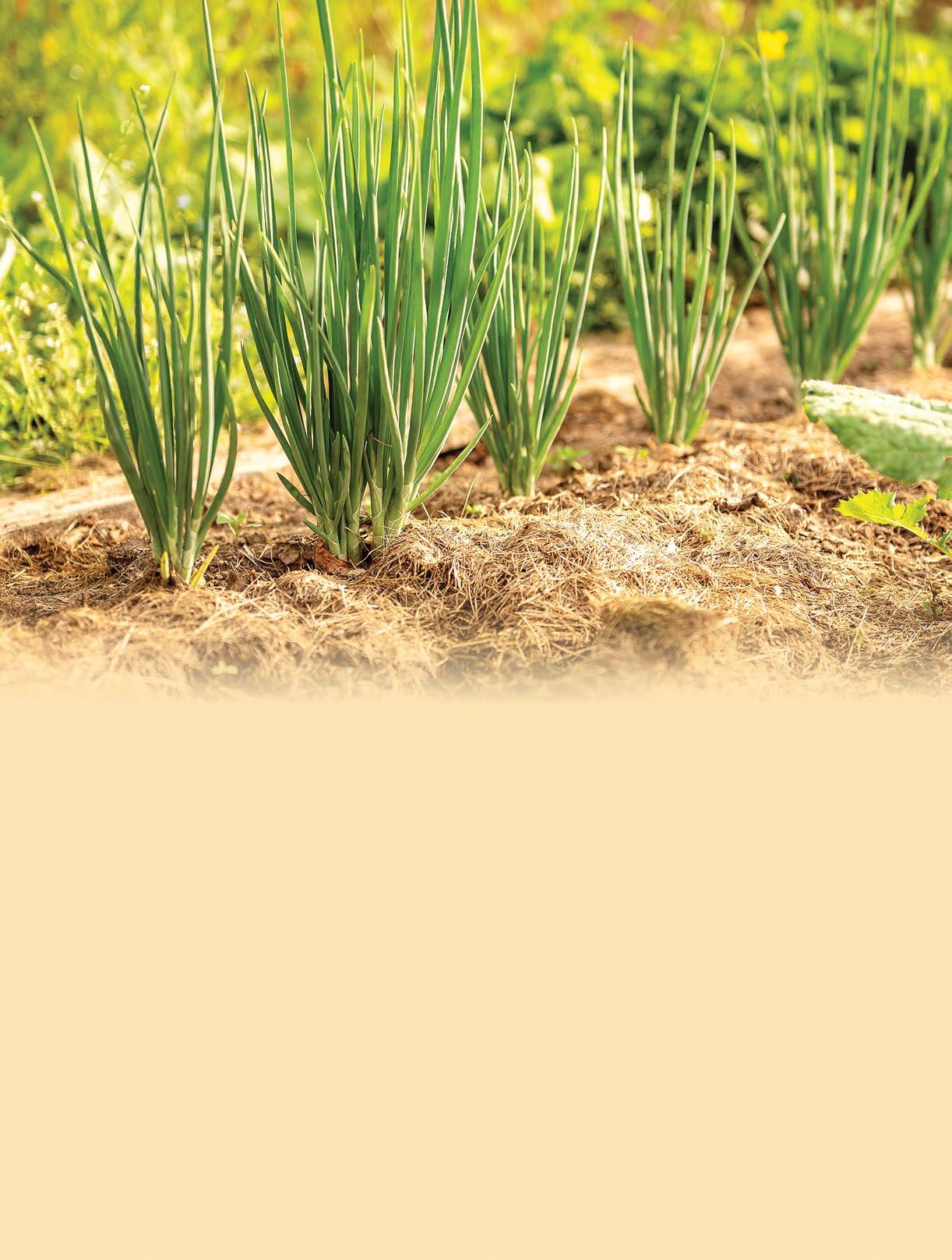
4 minute read
Straw bale gardening
Story by Shauna Dobbie, photos by Joel Karsten
If you have difficult to work soil and you want to start a vegetable garden in the spring, this is one solution. You line up bales of straw on any kind of ground, including concrete. You “condition” the straw, to get it to break down a bit. Then you plant your vegetables into the straw.
Advertisement
Take note that straw is not hay. Hay is made of grass and contains seeds. Straw is the stalk of grass after the grain has been harvested; it doesn’t (generally) contain seeds. You need straw and not hay for this kind of gardening.
The process takes quite a bit more water and added nutrients than gardening in soil, but you can get started on it without much backbreaking labour. On the other end of the growing season, you have a lot of spent straw, which is good for mulching your in-ground gardens or composting, but probably not for another year of straw bale gardening. You need to start with fresh straw every year, though you might be able to get two years out of your bales.
Conditioning the straw
In the spring, place your bales where they will get plenty of sun. Don’t assume that since you can move them when they are dry that you’ll be able to move them again; a typical straw bale is about 40 gallons, or 45 pounds dry. Once it’s saturated with water, it’ll weigh up to 300 pounds.
If the bales will be on soil or grass, you may want to put plastic or something beneath them. It’s hard to imagine weeds growing through 18 inches of packed straw, but a plastic barrier will prevent water from being sucked up by the ground below. Position the bales with the cut sides up.
Week 1: Soak the bales every day with water. On days 2, 4 and 6, sprinkle 3 cups of blood meal on each bale.
Week 2: On days 1, 2 and 3, sprinkle 1 ½ cups of blood meal per bale and water deeply. Water deeply for the next 3 days.
You can use any high-nitrogen fertilizer for this purpose but avoid any with pre-emergent herbicides and any that are slow-release.

Planting a starter plant.
Planting the bales
You’ll know the bales are conditioned if you put your hand on one and it feels about body temperature. If the bales are hot, they on their way; wait until they cool down to body temperature. If they’re cold, they haven’t started to condition yet. It could be that the surrounding temperatures haven’t been high enough and you’ll need to wait until it gets a little warmer.
Many people find it easier to put in bedding plants than to direct-seed. To plant bedding plants, put a divot into the soil about the size of the seedling pot. Place the seedling and tamp it in with more potting or garden soil. If you want to direct-seed, put a couple of inches of soil on top of the bales to plant the seeds into.
Growing the garden
Continue to fertilize at a heavy rate; liquid fertilizer, like liquid kelp, every couple of weeks should do it. And continue to keep the water flowing. This is like a hybrid between hydroponic and regular gardening. Many gardeners use drip irrigation for their straw bales.

You can’t see the straw by midsummer! The structures are for beans and other vining vegetables.

Cabbages and carrots.
Good for:
• Growing vegetables on a paved area
• Renters
• Gardening on sand or heavy clay
• Gardening on contaminated soil
• Avoiding soil-borne diseases
Not good for:
• Rooftops; the wet bales may be too heavy
• Perennials
• Corn, which is too tall
Where it all started and where it’s going
Apparently, straw-bale gardening goes back to ancient times; more recently, it has been discovered, used and codified by Joel Karsten, who started about 30 years ago. Karsten has a Bachelor of Science in Horticulture from the University of Minnesota. Although he lives on a small lot now, he grew up on a farm, and he noticed how weeds love to grow around straw, and how straw broke down.
When he bought his first house, he didn’t have enough money to build raised beds out of wood, so he decided to experiment with straw bales. Lo and behold, it worked. Then he wrote the book on it. By now, he’s written a few books on straw bale gardening. He also speaks on the topic, not only to garden groups around Minnesota and surrounding states, he’s taken his ideas to Cambodia.
Cambodia has particular problems with growing food because every year it has a flood season followed by a drought season. The flood season is not just wet, it’s drenched. And the drought season has extended periods of 38-degree plus weather.
Working with the Korean Trade Partners and other non-government organizations, Karsten is part of a team that has figured out a solution. A typical farmer has 2.5 acres of land. On that land, they use a backhoe to dig an enormous hole, 20 feet deep and 40 by 40 feet in area. The heavy clay that is excavated gets piled to one side and packed down.
Bales made of rice straw go on top of the berm and are planted there. They are not flooded out because the water drains down into the hole. The water that collects in the hole, too, stays around for use during the drought that follows the flood.
Alternatively, rafts can be constructed from bamboo, sturdy enough to hold bales for planting. The rafts float above the water in the rainy season.

Preparing the rafts for floating gardens in Cambodia.

Floating gardens in Cambodia.

Straw bale hydroponics.










